Purchasing a home is a significant milestone and you would want to get the most out of your investment. As of April 2025, the current mortgage rates Alabama have settled to a relatively lower rate after its 23-year high in 2023. In fact, after dropping almost every day for over a week, mortgage rates hit their lowest point so far in 2025. Slower economic growth and a gradual easing of interest rates are projected for later this year. So, based on the current mortgage rates in Alabama, is now a good time to invest?
At Defy Mortgage, we provide a streamlined and simplified home-buying process with 75+ non-traditional loan products tailored to your unique needs. Whether you’re an entrepreneur, freelancer, or real estate investor, we provide fast, reliable pre-approvals and solutions for complex loan situations. Our offerings range from government-backed options such as FHA loans and VA loans to non-QM options like bank statement loans and foreign national loans.
In this blog, we’ll provide a comprehensive overview of Alabama’s current mortgage rates. We’ll list the rates for other mortgage products, such as VA loans and FHA loans, and provide tips on how to lock in the best rates.
Let’s dive in!
What Are the Current Mortgage Rates in Alabama?
The average current mortgage rates Alabama are currently higher than in the years leading up to 2020, when rates rarely broke 5%, but typically follow the national average. Here are the approximate interest rates as of April 2025:
- 30-year fixed-rate mortgage: Approximately 6.734%. For reference, the national average for 30-year fixed mortgages is currently at 6.65% as of April 2025. Rate assumes 20% down, 720 FICO on a single-family home primary.
- 15-year fixed-rate mortgage: Approximately 5.791%. As of April 2025, the national average for this mortgage type is 5.89%. Rate assumes 20% down, 720 FICO on a single-family home primary.
- 5-year adjustable-rate mortgage (ARM): Approximately 6.868%. Rate assumes 20% down, 720 FICO on a single-family home primary.
- DSCR (Investors): Approximately 6.99% Rates assume 1.00 coverage ratio, and a 3yr prepay.
Alabama’s current rate has been on a steady downward trend in the past 2 years. In 2023, Alabama mortgage rates reached 7.8%, the highest they have been since 2000. This eventually declined to between 6.79% and 6.81% in early 2024.
Factors That Influence Mortgage Rates in Alabama
Understanding the elements that affect current mortgage rates in Alabama can help you secure better deals. Consider these key factors:
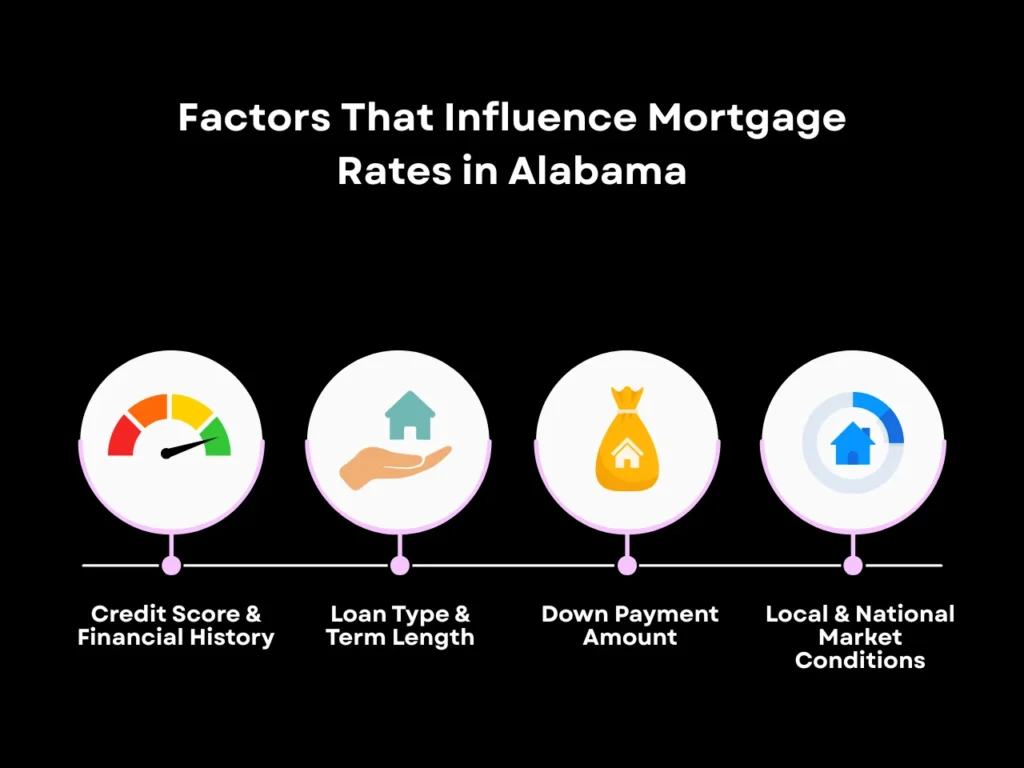
1. Inflation
The benchmark for mortgage rates nationwide is determined by macroeconomic factors such as inflation and Treasury yields. Although it has fallen significantly from its 2022 high of over 9%, inflation in the US remains higher than it was prior to 2020, staying at around 2.8%, above the Fed’s target of 2%.
Inflation decreases buying power and pushes mortgage providers to increase their rates. This directly impacts how much homebuyers will pay over the loan’s term.
2. Local Employment Rates and Economic Conditions
A state’s economic health can affect mortgage rates statewide. Alabama’s unemployment rose to 3.3% in February 2025 from 2.9% in January 2024, which could have contributed to its declining mortgage rates, as fewer people are able to afford homes. However, Alabama’s economy has also been experiencing a surge in commerce in recent years. A strong economy often increases housing demand, which could be balancing out the effect of unemployment.
Other factors that could contribute to its rate include housing market trends, with Alabama’s steady shift towards a buyer’s market possibly motivating mortgage providers to temporarily slow down their rate hikes to encourage more applications.
3. Federal Reserve Policies
Federal Reserve policies can also have a short-term indirect effect. Adjustments to the Fed funds rate can increase or decrease the rate at which banks can charge for lending out money to other financial institutions. This can indirectly influence mortgage rates by affecting buyer and investor sentiment and making it more expensive or inexpensive to borrow money in general. However, mortgage rates are still more affected by the need for mortgage-backed securities to compete with Treasury bond yields.
4. Credit Score & Financial History
The minimum credit score you need to meet will depend on the type of loan you want to secure. In general, lenders tend to view individuals with scores above 700 as less risky. The less risky you seem as a borrower, the more likely you are to be offered favorable terms. Here’s how you can improve your credit score and general financial profile:
- Pay bills on time: Delinquency in payments is one of the leading causes of low credit scores. You can strengthen your credit score by catching up on payments a few months before applying for a mortgage.
- Reduce outstanding debt: Paying down your outstanding debts can improve your credit score as well as reduce your overall DTI (debt-to-income ratio). DTI is the proportion of your monthly income that goes towards monthly debt payments. The lower the debt payments you have to make every month compared to your total income, the more confident lenders are that you can pay them back.
- Avoid taking on new debt: A few months before you apply for a mortgage, avoid taking out other loans, such as car leases and credit card applications. These hard inquiries will negatively impact your credit score in the short run.
5. Loan Type & Term Length
The structure of your loan can significantly impact the mortgage rate the lender extends you. Some loan types, such as jumbo loans, have higher rates than conventional loans. Other loan types can have higher interest rates because of other risk factors, such as the lack of a US credit history in the case of foreign national loans.
A loan’s payment period also affects rates. The choice between fixed-rate mortgages (FRMs) and adjustable-rate mortgages (ARMs) can influence rates in the following ways:
- Fixed-Rate Mortgages (FRMs): These offer a consistent interest rate over the loan’s life. This makes for more predictable payments, which can contribute to better financial stability. It also keeps your rate locked at the mortgage rate offered at the time you closed on your loan. This means you don’t benefit from future rate decreases, but you don’t have to worry about future rate increases either.
- Adjustable-Rate Mortgages (ARMs): These start with lower rates that adjust after a set period. This can lead to lower or higher rates in the future depending on mortgage rate trends.
The best loan type and term length for you will depend on your unique situation and goals. It’s often best to consult a trusted lender for advice on the options available to you. Defy’s mortgage experts are available 24/7 to help you choose the best loan product for your financial goals.
6. Down Payment Amount
A larger down payment typically reduces the lender’s risk, often resulting in better mortgage rates. Putting down 20% or more can also eliminate the need for private mortgage insurance (PMI), lowering overall costs except for loans where insurance is mandatory.
Best Loan Options for Alabama Homebuyers
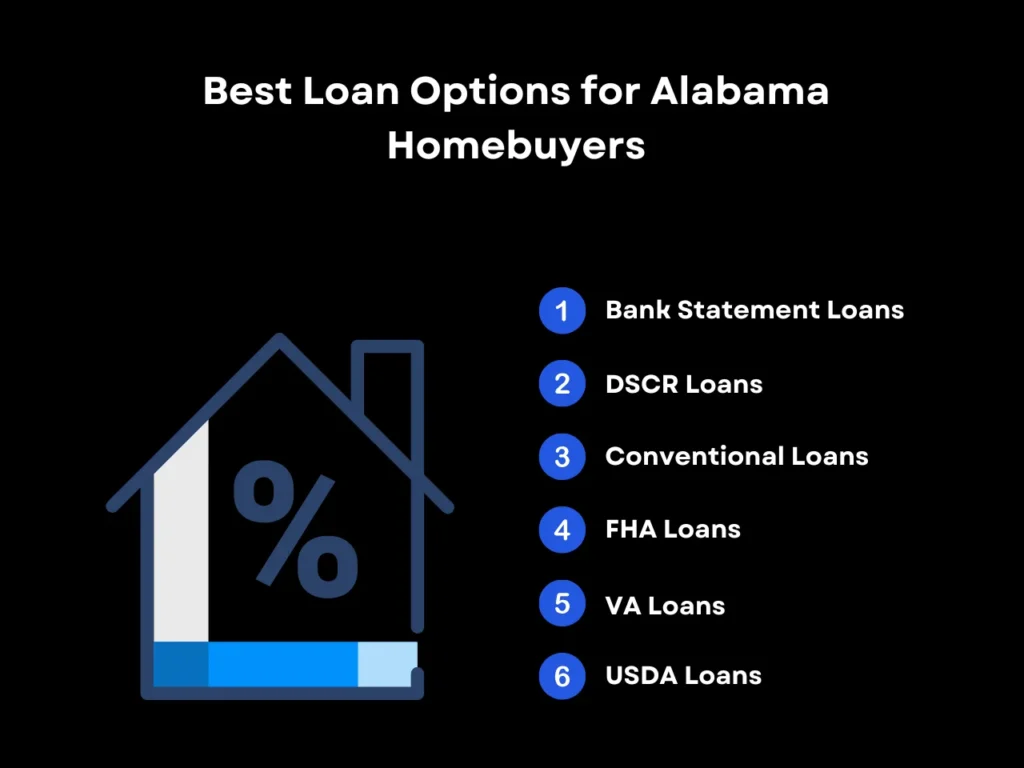
1. Bank Statement Loans
Bank statement loans are one of the more flexible mortgage options available to Alabama homebuyers, because they make use of bank statements to verify that you have enough income to cover mortgage payments instead of pay stubs or W-2 income.
Pros of bank statement loans:
- Allows diverse income sources: Unlike traditional mortgages that only account for W-2 income, bank statement loans allow self-employed borrowers, freelancers, or business owners to qualify using deposits shown on their bank statements.
- No tax return requirement: Bank statement lenders do not look at your tax returns or tax statements.
- Faster approval: Bank statements are an easier reference for the applicant’s income compared to tax returns, which contribute to a faster approval process.
- Less emphasis on credit score: Because you’ll be relying on bank statements to prove your creditworthiness, your credit score is less of a concern. At Defy, we offer bank statement loans to borrowers with FICO scores of at least 620.
- Potentially higher loan amounts: You can potentially qualify for a higher loan amount if your bank statements show sufficient cash reserves and income to cover it.
- High LTVs: Depending on the strength of your bank statements, lenders can offer to finance a larger portion of the loan. At Defy, we offer bank statement loans up to 90% LTV, meaning that you will only have to make a down payment of 10%.
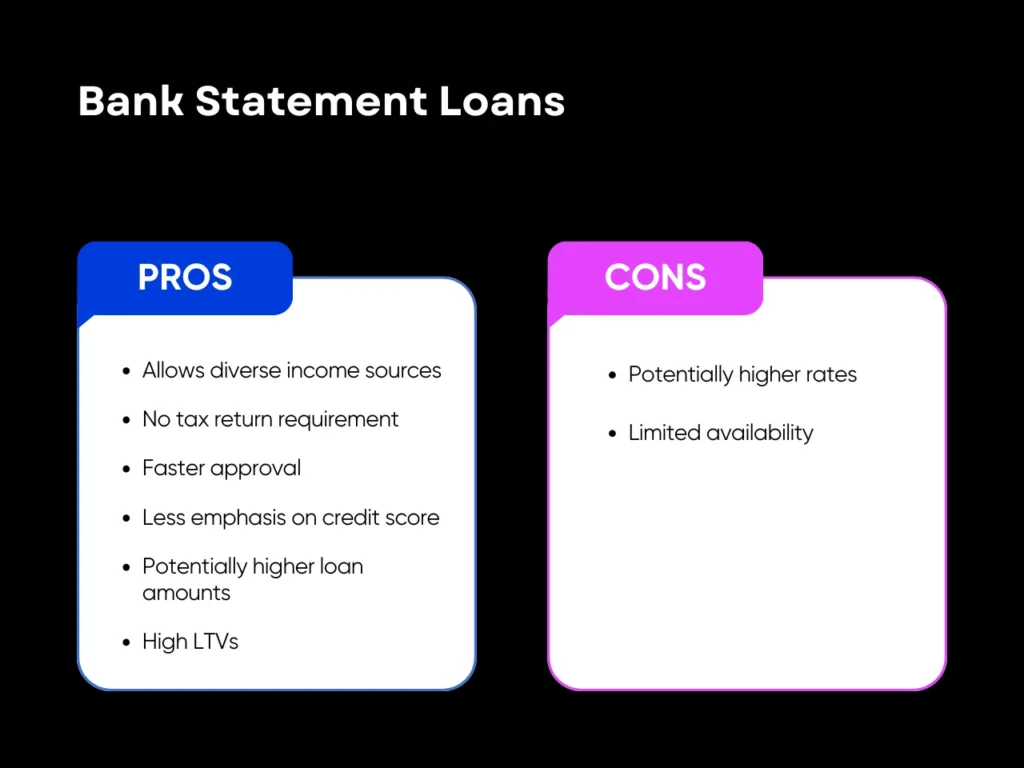
Cons of bank statement loans:
- Potentially higher rates: Depending on the risk that lenders perceive based on your applicant profile, your bank statement loan can have higher interest rates than other loan types.
- Limited availability: Bank statement loans are not typically offered by traditional banks and credit unions. They are most likely to be offered by non-QM specialists, like Defy.
2. DSCR Loans
If you’re looking to purchase Alabama homes to rent out, DSCR loans are your best mortgage option for minimizing cost and maximizing ROI. DSCR loan terms are defined according to a property’s debt service coverage ratio (DSCR), which is its annual income after deducting operating expenses divided by its total debt service, or the amount of debt payments and other fixed costs it needs to meet per year, such as property taxes.
Pros of DSCR loans:
- Flexible requirements: DSCR loans base eligibility on the property’s cash flow potential rather than the borrower’s personal credit or debt-to-income (DTI) ratio. With Defy, you can easily apply for a DSCR loan as long as you have a FICO score of at least 620.
- Loan terms based on cash flow: DSCR loan terms scale with a property’s rental income potential, meaning you can get highly competitive terms by selecting a property in an ideal location with healthy rental demand.
- Low state property taxes: Alabama has the second lowest state property tax rate in the United States, with an effective property tax rate of 0.36%. Such a low tax rate will have much less of an impact on your net operating income (NOI), resulting in a stronger DSCR ratio and better terms, such as less money down depending on the lender.
- No limit on number of properties: There’s no hard limit on the number of DSCR loans you can have active at any given time. This is perfect for those with rapid expansion in mind–as long as you select properties with a positive cash flow, you can simultaneously acquire all of them, boosting your portfolio by multiple properties almost instantly.
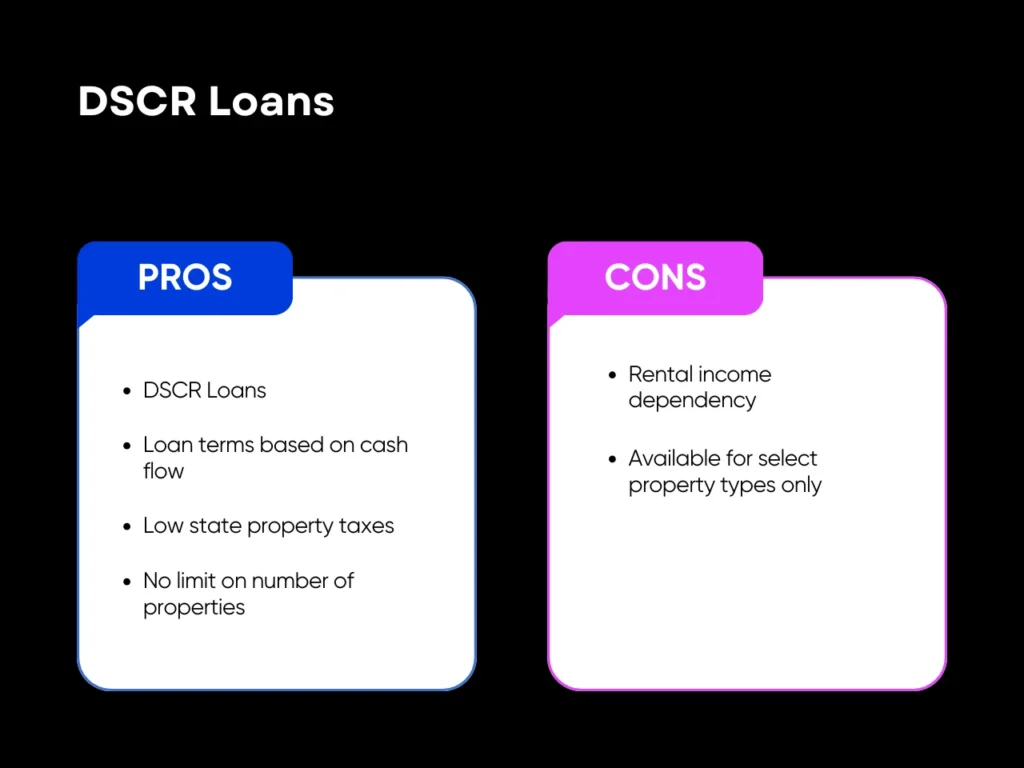
Cons of DSCR loans:
- Rental income dependency: The need for a property to exhibit good rental income potential means that DSCR loans are unsuited for buy-and-hold strategies that don’t involve renting.
- Only available for certain property types: DSCR loans are intended for investment properties only. This means borrowers are generally not allowed to live in homes purchased with DSCR loans. Some lenders may also impose their own property limitations–at Defy, for example, we limit DSCR loans for multifamily homes to 4 units (fourplexes).
3. Conventional Loans
Conventional loans are mortgages not insured or guaranteed by the federal government but instead rely on a guarantee from a private lender or a government-sponsored entity (GSE) like Fannie Mae or Freddie Mac. These loans are typically suited for borrowers with strong credit histories and stable incomes. They often come with competitive interest rates and flexible terms for those with ideal financial profiles.
Pros of conventional loans:
- Competitive interest rates: Borrowers with good credit scores may secure lower interest rates compared to government-backed loans.
- Can be used on any property: Unlike FHA loans or certain loan types intended for specific properties, you have complete freedom in the property that you want to purchase with your loan.
Cons of conventional loans:
- Stricter qualification criteria: Conventional loans typically require a higher credit score and lower debt-to-income ratio than other loan types. Most lenders look for a FICO score above 620, although 700+ is preferred, and a DTI of under 43%.
- Private mortgage insurance: Borrowers approved for a down payment of less than 20% must pay private mortgage insurance (PMI) until they build up enough equity.
Conventional loans are limited on a per-county basis depending on the median sale price of homes in that county. However, the conforming limit across the whole of Alabama is the same one as in most areas of the US, capping conventional loans out at $806,500 for the year 2025.
4. FHA Loans
Federal Housing Administration (FHA) loans are designed to assist first-time homebuyers and those with less-than-perfect credit by offering more lenient qualification criteria and lower down payment requirements.
Current rates in Alabama
FHA interest rates are typically lower than those of conventional loans to offset MIPs and make for easier payments. As of the beginning of April 2025, the average 30-year fixed-rate FHA loan in Alabama has a rate of 5.99%– almost 1 percent lower than conventional loans at 6.734%.
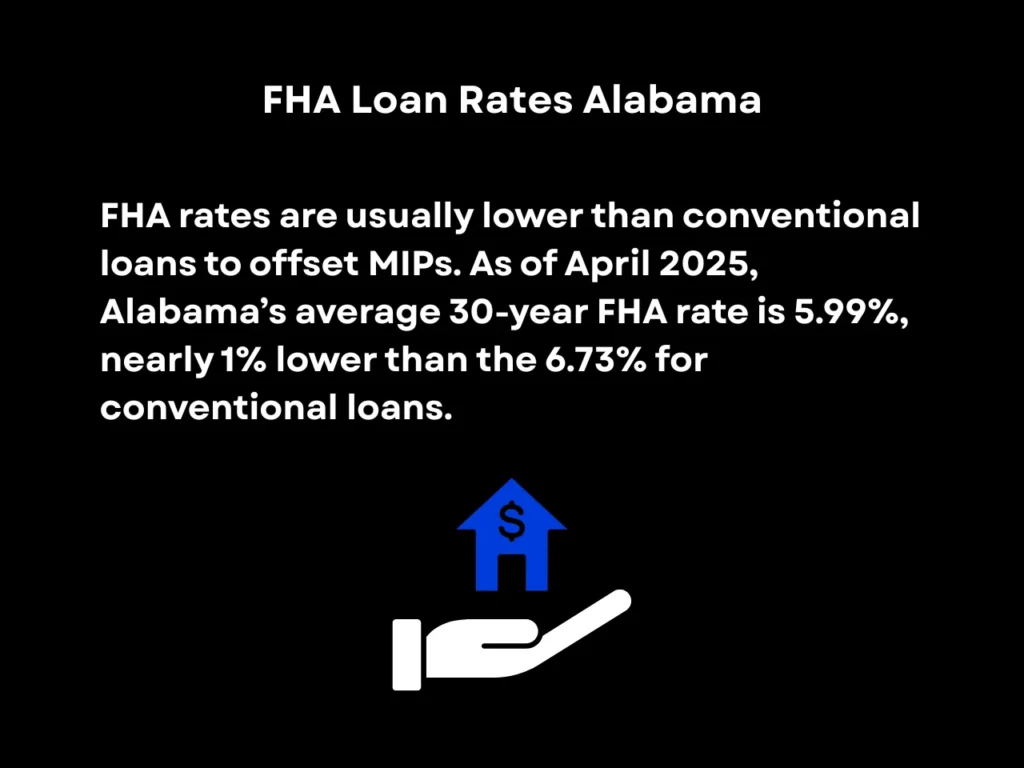
Pros of FHA loans:
- Lower credit score requirements: Borrowers with credit scores as low as 500 may qualify. However, a score of 580 or higher allows for the lowest down payment option and helps secure better mortgage rates.
- Low down payment: Borrowers with a FICO score above 580 can avail of the lowest down payment option of 3.5% of the home’s purchase price. Those with credit scores between 500 and 579 must pay a minimum of 10% down, but this is still much lower than most loans with a minimum of 20% down.
- Non-occupant co-borrowers: FHA loans allow you to add a co-borrower even if they won’t be living in the home, enabling you to split mortgage payments with family members or close friends.
- Assumable Loans: FHA loans can be transferred to a new buyer, which can be advantageous if interest rates rise.
Cons of FHA loans:
- Mortgage insurance premiums (MIP): FHA loans require both an upfront premium (1.75% of the loan amount) and annual premiums (ranging from 0.15% to 0.75%), increasing overall loan costs. Unlike conventional loans, you will have to pay MIPs regardless of your down payment and generally have to do so throughout the life of the loan.
- Restricted to specific property types: Only primary residences can be purchased with an FHA loan. For multi-family homes, borrowers are usually limited to properties with up to four units. They must demonstrate that their rental income generated from each unit is sufficient to cover the mortgage costs.
- Minimum property standards: Homes must meet specific minimum property standards (MPS) for safety, security, and structural soundness. This may limit your property options, or force you to pay for renovations so that your chosen property can meet the FHA’s standards.
Like conventional loans, FHA loans are also capped at a county-specific limit, or $524,225 for a single unit in 2025.
5. VA Loans
Veterans Affairs (VA) loans are mortgages intended to support veterans and active-duty service members on the path to homeownership. The surviving spouses of veterans who died in the line of duty or due to a service-connected disability can also apply, provided they do not remarry before the age of 57.
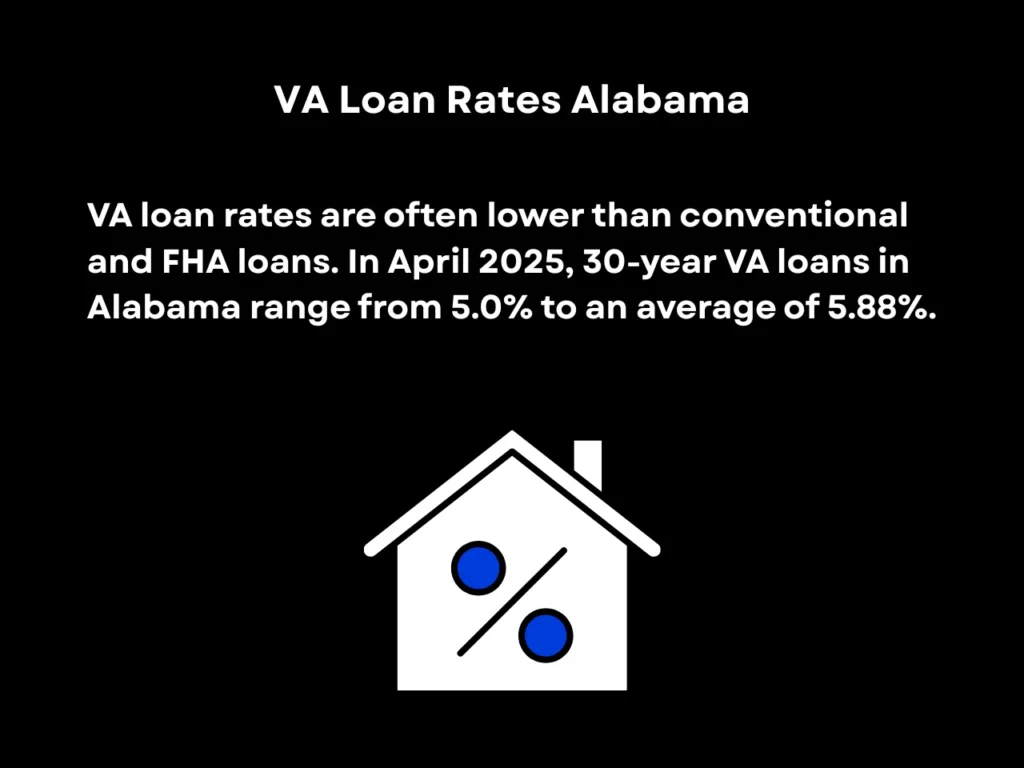
Current rates in Alabama
VA loan rates are often much lower than those of conventional or even FHA loans. As of April 2025, mortgage rates for 30-year VA purchase loans in Alabama can go as low as 5.0%, although most average around 5.88%.
Pros of VA loans:
- No down payment required: Qualified borrowers can finance 100% of the home’s value without a down payment.
- No private mortgage insurance (PMI): Unlike conventional and FHA loans, VA loans have no need for PMI, reducing monthly payments.
- No official loan limit for those with full entitlement: Eligible veterans, service members, and surviving spouses with full entitlement can borrow as much as their lender will allow for loans above $144,000.
Cons of VA loans:
- Funding Fee: A one-time funding fee is required, typically 2.15% of the loan amount, but it can be as high as 3.3% or as low as 0.5%, depending on service history and the specifics of the loan. However, this funding fee can be rolled into your monthly payments and can even be waived entirely if your disability rating is high enough.
- Primary Residence Requirement: The loan must be used for a primary residence, not for investment properties or vacation homes.
6. USDA Loans
USDA loans are government-backed mortgages designed to assist low- to moderate-income borrowers in purchasing homes in eligible rural and suburban areas. These loans are part of the U.S. Department of Agriculture’s Rural Development program and aim to promote homeownership in less densely populated regions.
Current Rates in Alabama
USDA loans are highly competitive, with the USDA setting the interest for Single Family Housing Direct home loans at 5.0% as of April 1, 2025.
Pros of USDA loans:
- Flexibility in eligible areas: Homes in areas with less than 2,000 housing units and 5,000 residents are potentially eligible for USDA loans. This can include small towns, villages, and even some suburban areas. For a more accurate look at which homes can apply, you can use the USDA’s eligibility map.
- No down payment required: Similar to VA loans, qualified borrowers can finance 100% of the home’s purchase price without needing a down payment.
- No mortgage insurance required: USDA loans also don’t require you to pay for private mortgage insurance.
- Lenient credit requirements: USDA loans have more lenient credit score criteria. The USDA doesn’t enforce an official minimum credit score, and lenders typically only require borrowers to have FICO scores of 620-640 or higher.
Cons of USDA loans:
- Only for rural properties: Because of their eligibility requirements, USDA loans are only available to those who live in rural or sparsely populated areas.
- Upfront and annual fees: Despite the lack of PMI, USDA loans require an upfront guarantee fee of 1% of the home’s purchase price, plus an annual fee of 0.35%, which in effect acts as an equivalent to private mortgage insurance.
- Must be a primary residence: Like VA loans and FHA loans, USDA loans can only be used to buy primary residences.
- Income limits: To be eligible for a USDA loan, your household income must not exceed 115% of the median income for your area. Fannie Mae’s Area Median Income Lookup Tool can help you check whether you fall within this bracket.
How to Lock in the Best Mortgage Rate in Alabama
It’s best to monitor the current mortgage rates in Alabama and lock in the rate that works for you. This means that your mortgage rate will stay fixed even through future rate hikes or drops. Here’s how you can lock in the best rate:
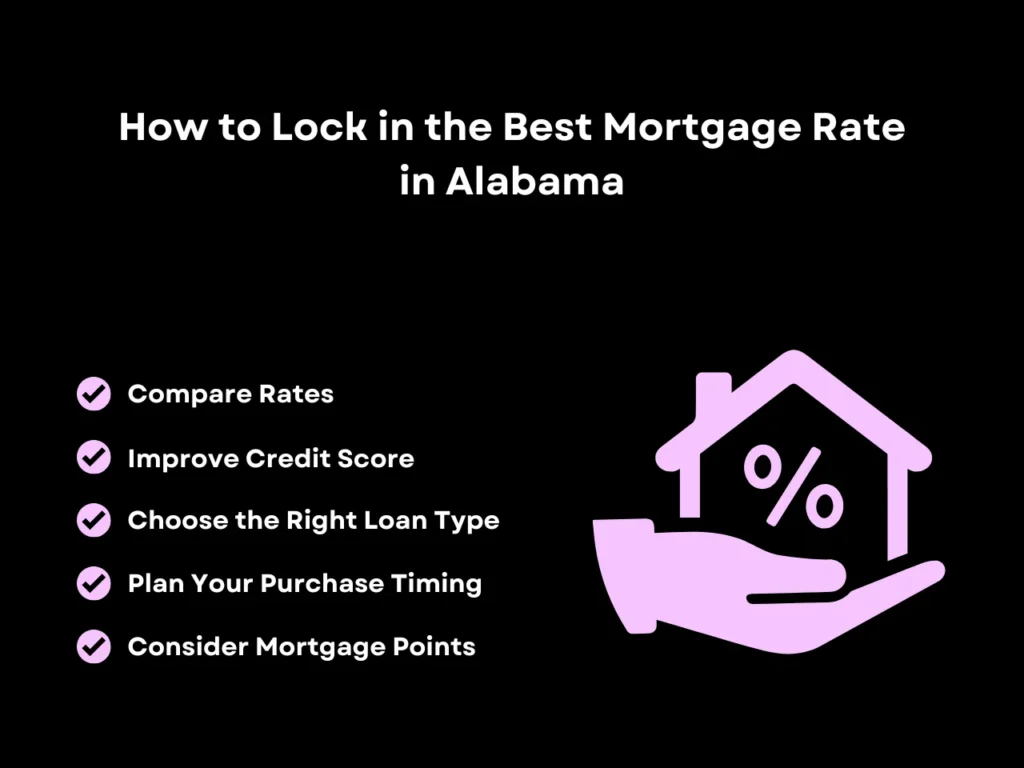
Disclaimer: This is not financial advice. We do not provide financial advice at Defy. This is only a collection of best practices that lenders and experienced borrowers have found to yield the best results in terms of getting a good mortgage rate.
1. Compare Rates from Multiple Lenders
Be sure to request Loan Estimates from several lenders for the same loan type—these documents break down rates, fees, and closing costs, making it easier to compare offers accurately.
Fees can vary widely, so weigh them carefully. Reach out to a mix of lenders, including banks, credit unions, and brokers, to see what deals are available. You should also pay attention to the Annual Percentage Rate (APR) provided by the lender, which reflects the full cost of borrowing.
2. Improve Credit Score Before Applying
A strong credit score can unlock lower mortgage rates and better loan terms. Start by cross-checking your reports from major credit bureaus like Equifax, Experian, and TransUnion, and dispute any errors that might be dragging your score down. Your payment history carries the most weight, so make it a point to pay your bills on time. Consider setting up reminders or autopay to stay on track.
It also helps to keep your credit utilization below 30% by paying down balances and holding off on big purchases or applying for new credit shortly before applying for a mortgage. Reducing overall debt can also improve your debt-to-income ratio, making you more attractive to lenders and helping you qualify for more favorable rates.
3. Choose the Right Loan Type
The right loan type can offer you the best mortgage rate for your unique situation. A USDA loan, for example, may be better for you than an FHA loan if you live in an area that falls under USDA loan eligibility.
Similarly, the choice between a fixed-rate or adjustable-rate mortgage can also be pivotal, with adjustable-rate mortgages offering the potential for lower payments in case mortgage rates go down, while fixed-rate mortgages providing insulation in the event that mortgage rates go up.
4. Time Your Purchase Strategically
Mortgage rates across the US are currently on a downturn, with some experts projecting that the average will fall to the mid-6% range by Q4 2025. However, this opinion may change in response to sudden economic developments. Monitoring key economic indicators such as inflation and the bond and stock markets can help you identify the best time to close on a home purchase. Fed Rate decreases can also cause temporary drops in mortgage rates, which could make the period leading up to one an ideal time to purchase.
The general forecast is also not a guarantee that rates will keep falling in your area. Rates can also be influenced by local economic factors, including employment rates and regional development projects. Observe these trends and look up how they have historically affected mortgage rates in your area to identify periods when mortgage rates are lowest.
5. Consider Mortgage Points
Some lenders offer the option to purchase mortgage points, which are upfront fees you can pay at closing to reduce your loan’s interest rate. One point typically costs 1% of your total loan amount and can decrease your rate by 0.25%, depending on the lender. This strategy can make sense if you plan to stay in your home long enough to recoup the upfront cost through lower monthly payments.
To decide if buying points makes sense for you, calculate your break-even point, which is the time it takes for your monthly savings to equal the upfront cost. For long-term homeowners, paying points can mean significant savings over time. However, if you plan to move or refinance within a few years, the upfront expense may not be worth it. Always ask your lender to provide rate quotes with and without points so you can compare them side by side.
Current Mortgage Rates Alabama FAQ
What are the current mortgage rates in Alabama?
As of April 5, 2025, the average interest rates in Alabama are 6.734% for a 30-year fixed mortgage and 5.791% for a 15-year fixed mortgage. These rates assume that the borrower has a FICO score of 720, and has made a 20% down payment on a single-family home primary.
How do Alabama’s mortgage rates compare to national averages?
Alabama’s mortgage rates are generally in line with the national average rates. For instance, the national average for a 30-year fixed-rate mortgage was 6.65% as of April 5, 2025, and the average for Alabama was 6.734%. These rates apply for single-family home purchases, with a 20% down payment and a borrower credit score of 720.
What are the current mortgage rates for Alabama real estate investors?
Mortgage rates for investment properties in Alabama depend on the type of loan used to purchase the property, as well as the loan amount, down payment, borrower’s credit score, and other factors. DSCR loans in Alabama, for example, can range from 7% up to 8.875%.
What are the benefits of investing in Alabama real estate?
Alabama offers several advantages for real estate investors, chief among these is its low effective property tax rate of 0.36%–perfect for boosting a property’s DSCR for those who want to take out a DSCR loan . The state also has landlord-friendly regulations, such as no rent control laws, full control over the terms and conditions of the lease agreement, and no state-level requirement to have a license to rent out property (individual cities and counties may impose their own requirements). AL also experiences healthy housing and rental demand, thanks to its thriving job market and commercial boom.
What credit score is needed for the best mortgage rates in Alabama?
A higher credit score typically qualifies you for better mortgage rates. Conventional loans often require a minimum credit score of 620, but a score of 700 or higher can help secure the most favorable rates. For FHA loans, a score of 500-580 minimum is generally required. DSCR loans also have a minimum score of 620, but you don’t need a higher credit score to get better terms–instead, these depend on the cash flow performance of the property.
Are there any first-time homebuyer programs in Alabama?
Yes, Alabama offers programs like the Step Up program, which provides down payment assistance and competitive interest rates to eligible first-time homebuyers. Keep in mind that every lenders loan options for first-time homebuyers are different, so be sure to reach out to your lender of choice to explore their options.

How often do mortgage rates change in Alabama?
Mortgage rates can fluctuate daily based on economic indicators like inflation, Treasury bond yields, and market conditions, with Federal Reserve policies having an indirect effect as well. It’s best to monitor rates regularly when planning to purchase a home.
Key Takeaway
With many experts predicting that the current mortgage rates Alabama will continue on their downward trend for the rest of the year, affordability is likely to increase as 2025 progresses. However, this can also drive up demand, which could increase the list price of homes. Carefully monitor your local market to lock in the best rate and purchase price possible if you intend to buy a home in the near future.
If you’d like personalized guidance on the mortgage solutions available to you whether in Alabama or a different state, don’t hesitate to reach out to Defy today. Schedule an appointment with our mortgage experts who can help you tailor the perfect custom loan product to fit your homeownership goals.



